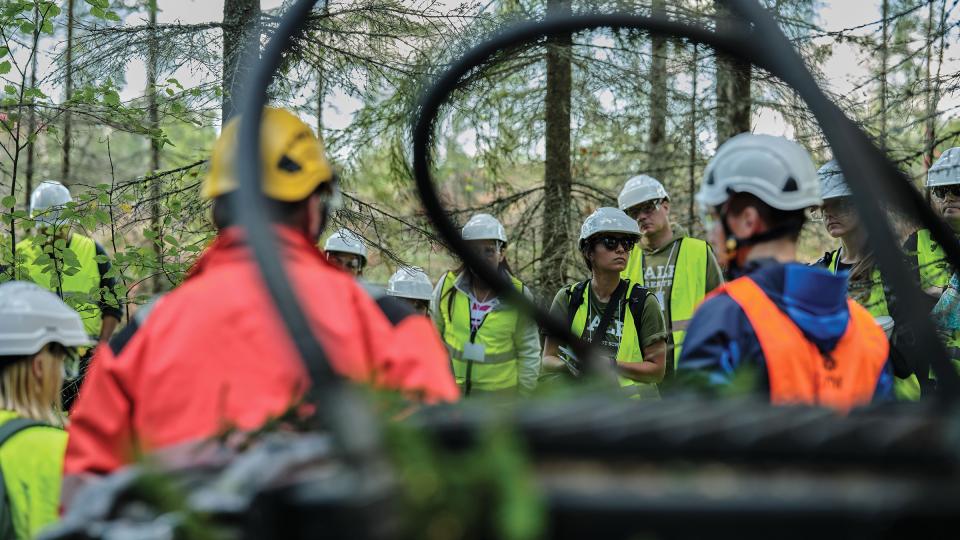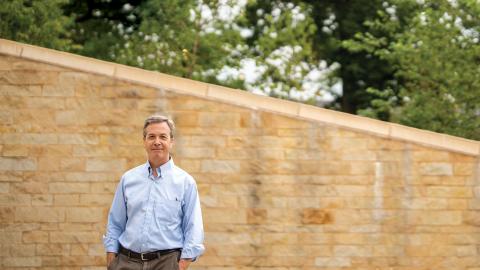

Participants tour UPM’s production forest in Finland during the first day of the dialogue on September 12, 2022. European birch is collected there by the mass timber company to be used as pulp. Photographs by Samuli Skantsi
The Forests Dialogue Engages Stakeholders on Mass Timber’s Role in a Sustainable Future
With global demand for more energy-efficient housing and infrastructure increasing dramatically — the world is adding a new city of 1 million every 10 days — sustainable construction will be key to mitigating climate change. A recent study published in Environmental Science and Technology, estimating the carbon emissions of building additional infrastructure to house a population of 9.3 billion people in 2050, found that using common building materials, like concrete and steel, would emit so much additional CO2 into the atmosphere that it would likely compromise our ability to keep warming below 2 degrees Celsius. Climate positive forest products, specifically mass timber, can play an important role in constructing carbon-storing buildings and reducing fossil fuel emissions.

In September, The Forests Dialogue (TFD) convened in Finland, which is one of the nations leading the world in mass timber production, to bring stakeholders together on its potential and use. Alan Organschi ’88 MArch — a key adviser to TFD who attended the dialogue in Finland and co-taught the Yale Forest Forum’s speaker series on mass timber — says it is a key climate restoration tool. It can transform urban areas from sources of CO2 emitters to carbon sinks.
Organschi directs the Regenerative Building Lab at the Yale School of Architecture and is principal and partner at Gray Organschi Architecture in New Haven. The firm runs Timber City, a multiyear research project that explores the environmental efficacy of mass timber construction technologies. He has been working on several projects across the globe that utilize mass timber, including construction projects in Bhutan, Africa, and Berlin.
“We’re seeing surprisingly rapid market adoption of mass timber and it feels as if it’s accelerating,” says Organschi, who also directs Bauhaus Earth in Berlin.
Building regulations are adapting to allow mid- and high-rise buildings made from mass timber, and mass timber products are financially competitive with steel or reinforced concrete assemblies, which are carbon emitters, he notes.
“When we build with conventional mineral-based structural materials, there is a spike of carbon emissions and other impacts that happen right at the beginning of the building life cycle. This is an environmental debt that will take a long time to pay off in even the most operationally efficient buildings. So, we need to focus on renewable, bio-based, carbon-storing alternatives that have lower processing emissions. We believe these substitutions could really start to move the needle,” he says.
YSE Pinchot Professor Emeritus Chad Oliver ’70 MFS, ’75 PhD, who has worked with Organschi on mass timber’s potential, says they have both found that concerns about mass timber’s impact on forests have swayed public opinion. There is also resistance within the building supply chain and hesitance among companies to turn away from traditional steel and cement manufacturing at plants they have spent decades financing.
One particular concern, they note, is that cutting trees for mass timber production will harm forests and increase carbon emissions. While tree roots will decompose and emit carbon after a tree is cut, the wood from the trees that will be used to construct buildings will store carbon for at least another 100 years. In addition, the new trees that will emerge in less-dense forests, and ones that are planted, will sequester carbon.

Participants visit a structure utilizing multiple forms of mass timber during the second day of the dialogue on September 13, 2022.
Approximately 1.15 billion hectares of global forests — or about 30% of all forests — are managed primarily for production of wood and nonwood forest products. Additionally, 749 million hectares are designated for multiple use, which often includes production, according to the 2020 Global Forest Resources Assessment by the Food and Agriculture Organization of the United Nations. Oliver estimates that if one-half the currently unharvested annual growth in forests (another 1.3% of the standing forest volume) is made into cross-laminated timber and other mass timber products, 1.5 million 11-story buildings could be constructed each year with 152 million single-family apartments, housing 3% of the world’s population. In 40 years, according to Oliver, the entire global population could be living in wood housing.
“Wood buildings constructed from mass timber can create a sea change,” Oliver says.
During TFD’s weeklong meeting in Helsinki, representatives from across the forest product supply chain — including environmentalists, landowners and managers, architects, builders, academics, and government officials — gathered to observe and discuss current forest practices, mass timber manufacturing, and supply chain processes. To advance sustainable construction, Finland, along with Iceland, Norway, and Sweden, launched the Nordic Wooden Cities initiative, which promotes timber building techniques in residential and commercial buildings.
The Finland dialogue focused on several of the key issues surrounding mass timber, including impacts on forests, the reality of stored carbon, and public perception of forest uses.
“Mass timber is one piece of the sustainability puzzle, and it can be an overall benefit to the environment,” says Gary Dunning, executive director of TFD and The Forest School at YSE, who facilitated the dialogue. “We need to figure out the best way to use mass timber so it is forest friendly, climate friendly, and people friendly.”
Mass Timber Supply Chain
During The Forests Dialogue trip to Finland September 2022, participants visited sites representing the mass timber supply chain. The sites included an industrial timber plantation, a smallholder forest that provides timber to cross laminated timber (CLT) manufacturers, a conservation forest that protects at-risk species within the context of production forests, a CLT processing site, and a mass timber building under construction.
From the forest...



...to the processing site...


...to the construction site.






